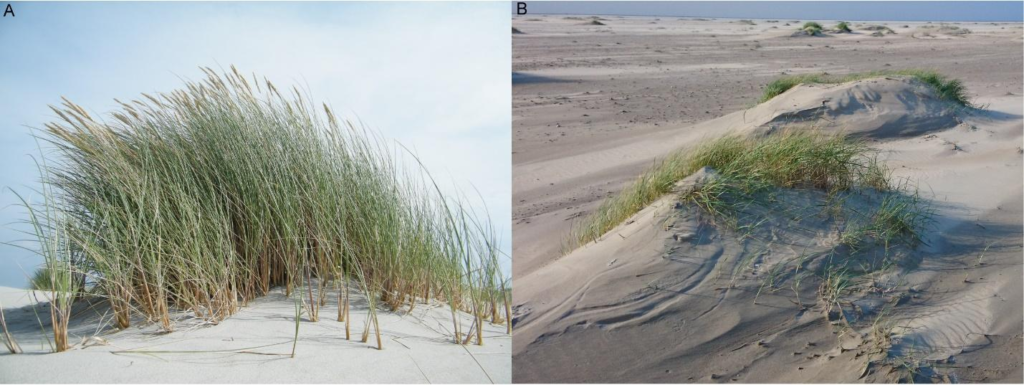Terrestrial ecology
Knowledge on early dune development is essential to enable more accurate prediction and even stimulation of new dune formation through sand nourishment. The first objective in this topic focuses on understanding of fundamental ecological processes to make better choices for nature conservation and management on sandy beaches. The second objective focused on identifying boundary conditions for the development of embryo dunes and elucidate the mechanisms underlying dune building.
Washed ashore
by Emily van Egmond
Small animals, such as worms and insects, that are present on the beach, are crucial to the sandy beach ecosystem because this intertidal macroinvertebrate community is at the core of the sandy beach food web. Macroinvertebrates feed on organic material from the sea while shore birds feed on these small animals. Analyses of community patterns in the field together with indoor experiments have been performed to unravel mechanisms of community assembly.
There are two main findings resulting from this research. First, it was found that a mega sand nourishment such as the Sand Motor creates novel habitat for intertidal macroinvertebrates by enhancing the spatial heterogeneity of the sandy beach. By constructing this hook-shaped mega-nourishment, a new habitat type was created along the Dutch main coast in the form of a sheltered lagoon. This attracted intertidal macroinvertebrate species (such as the amphipod Corophium volutator) that are typical for mud-flats and are not found on wave-exposed sandy beaches. In other words, the lagoon at the mega-nourishment harbored a distinct community compared to typical wave-exposed sandy beach communities. Therefore, this habitat type increases total macroinvertebrate species richness along the Dutch main coast. In future mega-nourishment designs, heterogeneity on the landscape scale would be crucial to enhance biodiversity.
Furthermore, the wave-exposed beaches of the Sand Motor harbor a dissimilar intertidal macroinvertebrate community compared to beaches subject to regular beach nourishment and no nourishment. It remains important to note that a mega-nourishment changes the environment in a different way than regular beach nourishments, resulting in an altered intertidal macroinvertebrate community with potential cascading effects on other trophic levels within the sandy beach ecosystem.
Secondly, it was found that beach-cast sea weed is crucial to attract supratidal macroinvertebrate species and support beach pioneer plant growth. The older and more decomposed the beach-cast sea weed, the higher the abundance of macroinvertebrates. Also, different communities were found in spring, summer and autumn, showing a great variability in especially fly species across seasons. It is of great importance to leave organic material cast on the beach, including sea weeds, untouched as much as possible, as it supports the sandy beach ecosystem. In continuation of the current beach management on the Sand Motor, removing garbage only and leaving organic matter at the drift lines on future mega-nourishments would greatly enhance the ecological value of the sandy beach.

Embryo dune development
by Marinka van Puijenbroek
This research showed that for the development of embryo dunes beach width is often limited, while wider beaches enable the development of large embryo dune fields. Sand nourishment can increase or stabilize beach width, which promotes embryo dune development. Growing season precipitation has an positive effect on embryo dune development, whereas embryo dune area decreases in periods of high storm frequency or intensity.
Dunes show a seasonal cycle of summer accumulation and winter erosion. It was found that dune growth in summer is mainly determined by dunes size, where large dunes increased more in volume than smaller dunes. In winter dune growth was determined by vegetation.
Dunes with a dune building species with lower vegetation density (biestarwegras) had a lower growth rate compared to dunes with a dune building species with higher vegetation density (helm).
Growth of exposed dunes was likely restricted by storm erosion, whereas growth of sheltered dunes was restricted by sand supply.
Dune development depends on the germination of dune building species; it was found that soil salinity is not limited for the growth of E. juncea (biestarwegras) and that therefore subsequent dune development is not limited by soil salinity. The survival of dune building grasses is more determined by storm intensity.
The Sand Motor has a wide beach, therefore there is a large potential for dune development. However the Sand Motor is quite high, which has two main consequences. First it results in a lower groundwater level compared to natural beaches, which limits the germination and growth of dune building grasses. Secondly it reduces storm impact, which reduces the erosion dunes experience in winter. Dune development at the Sand Motor is limited to the lower situated areas, since there more water is available. However, do to the absence of storms, the vegetation that develops there does really well.

More information on these topics can be found in this book.
